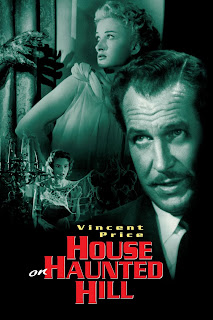Back in 2016, we viewed the non-musical Ronald Colman version of Kismet (1944). Also filmed in color, that version was a delightful fairy tale, with strong performances from Mr. Colman and Marlene Dietrich. The musical version is much the same story, but it's hard to compare it to the earlier rendition, precisely because it is a musical. The addition of the lush score changes the whole dynamic of the film, making it a very different experience.
Howard Keel is excellent as The Poet. He's actually too young for the part - he is only nine years older than his "daughter," Ann Blyth (Marsinah). But he is so engaging and appealing you really don't care. If we had one complaint, it was that he doesn't get to sing the most exquisite song from the production, "Stranger in Paradise". That pleasure goes to Vic Damone (Caliph), who has a pleasant voice, but nowhere near the richness of Mr. Keel's bass-baritone. Mr. Keel was second choice for the part - Ezio Pinza was the original selection of Arthur Freed (TCM article).
After working in public relations, Howard Keel was hired as the understudy for John Raitt in Carousel - he would appear in the role while Mr. Raitt was on vacation. (PBS) He next became the replacement for Alfred Drake in Oklahoma! (Mr. Drake was the original Poet in Kismet). Mr. Keel would eventually appear in 6 Broadway plays. His breakout film role was as Frank Butler in Annie Get Your Gun (1948), but his ultimate singing partner was Kathryn Grayson - they co-starred in Show Boat (1951) and Kiss Me, Kate (1953). After leaving MGM (following Kismet), he continued to appear on film and television; then in 1981, he became a regular on the television show Dallas as Clayton Farlow, Miss Ellie's second husband. He would continue with Dallas for the next 10 years; the show had the added benefit of introducing him to a new audience, and invigorating his singing career (though he never actually sang on the show!). Mr. Keel died in 2004, at the age of 85. (Guardian obituary)
Also outstanding is Dolores Grey; she makes Lalume into a sultry seductress, and her musical routines are memorable. It was surprising to learn that she was upset by the daylight shoot of the film, fearing it would show up flaws in her complexion (A Hundred or More Hidden Things: The Life and Films of Vincente Minnelli by Mark Griffin). She need not have worried, She looks awesome. Cyd Charisse was under consideration for the role (AFI catalog) and while she certainly had the dancing ability (let's face it, she could outdance anyone!), her singing was not at Ms. Gray's level.
Ann Blyth has a beautiful singing voice, and she is an excellent actress, but the part of Marsinah is so terribly small, she feels almost wasted. She does get to sing the lovely "Baubles, Bangles, and Beads" and supports Vic Damone in "Stranger in Paradise". She's at her best with Howard Keel - he gives her someone to bounce off. She's less engaged with Vic Damone, which is not her fault. He's stiff and flat when he is not singing, it's as though he thinks he making a record album. It probably didn't help that director Vincente Minnelli, usually an actor's best support, was downright unpleasant to Mr. Damone during the shoot. This was not a film Mr. Minnelli wanted to make; as a result, he went quickly, sometimes to the detriment of his actors (That Was Entertainment: The Golden Age of the MGM Musical by Bernard F. Dick).
There are some interesting supporting parts worth a mention - Monty Woolley as Omar the merchant, who starts The Poet on his long, strange journey (this was his last film appearance). Sebastian Cabot as the Wazir, a wicked man plotting to line his own pockets at the expense of his Caliph. Mike Mazurki appears in the small role of a policeman. Jack Elam (Hasan-Ben), Jamie Farr (Orange Merchant), Ted de Corsia (Policeman), and Barrie Chase (Harem Dancer) also appear - some in parts that if you blink, you will miss them (but worth looking for!)
While being able to view the film on demand in your own home is wonderful, this Cinemascope production does lose some of its impact when shown on a small screen. One of our members commented that so much was going on, it was hard to concentrate on it as she watched on her computer monitor. It's a film that begs for a big screen revival.
Kismet had many lives, most of them as a straight play (see our post on the Ronald Colman film, linked above). The musical opened on Broadway in 1953, with Alfred Drake as The Poet, Doretta Morrow as Marsinah, and Richard Kiley as Caliph (Neile Adams as a Dancer). It ran for 583 performances.
The New York Times review of the film by Bosley Crowther was lukewarm. It paled by comparison to the stage version, but did receive positive review for Mr. Keel and Ms. Gray, and for the music. It had a Christmas release at Radio City Music Hall, but lost money for MGM.
Kismet is not a bad film - it could have been better, but is well worth seeing for Mr. Keel, Ms. Grey, and Ms. Blyth. We'll leave you with a trailer:























